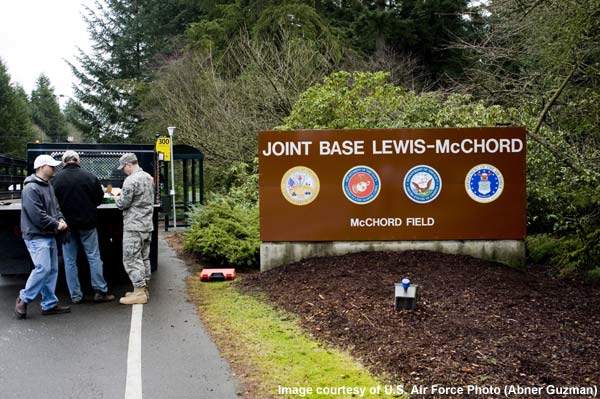Joint Base Lewis-McChord (JBLM) is an army base located 14.6km southwest of Tacoma in the Pierce and Thurston counties of Washington, US. It was inaugurated on 1 February 2010. The JBLM was formed following the merger of the Fort Lewis Army and McChord Air Force bases. The merger, costing around $8.5m, was planned to reduce the individual base’s operating costs among other reasons.
JBLM is now the largest military installation on the west coast of the US. It covers 90,836 acres in Pierce and Thurston counties together.
The base is anticipated to act as a power projection base throughout the world. It is engaged as a Department of Defense hub for air, ground and sea transportation. The army and air force personnel act through separate service missions.
The transition to the joint base began in January 2010 with an initial operational capability. The final operational capability began in October 2010. During the nine months, different complex units were integrated into the joint base structure in three stages.
The joint base includes JBLM McChord Field, JBLM Lewis North and JBLM Lewis Main. McChord AFB got converted into JBLM McChord Field, North Fort into JBLM Lewis North, along with the Main Post into JBLM Lewis Main. JBLM Lewis Main is the headquarters of the base.
Military missions of both the army and air force units remain separate. More than 25,000 soldiers and civilian workers are present at JBLM. It supports around 120,000 retirees and more than 29,000 family members who live both on and off post.
Joint Base Lewis-McChord history
Fort Lewis Army base opened in 1917 as Camp Lewis. Spread over an area of 87,000 acres (350km²), the base got its name from Captain Meriwether Lewis who belonged to the Lewis and Clark expedition. Around 60,000 soldiers were trained in the base during World War I.
Fort Lewis discharged its maiden soldiers during the conclusion of World War II. The fort’s northwest staging area was used as a separation centre during the same time.
Tacoma Field opened in 1930 as an airfield adjacent to the Fort Lewis army base. It was renamed in 1940 as McChord Field after Colonel William Caldwell McChord, former chief of the training and operations division in the HQ Army Air Corps.
The area of the field grew subsequently and in 1948, it was named the McChord air force base. The base was used for training pilots and as a clearing station during the Pacific War.
In November 2005, the base realignment and closure (BRAC) process recommended the merger of the Fort Lewis and McChord air force bases. It was one among 12 joint base installations created globally as part of the mergers.
The BRAC recommendations were accepted and planning for the joint base began in the same year. A memorandum of agreement (MOA) was signed by the army and air force in September 2009.
JBLM design and construction
JBLM is one of the largest and the biggest military reservations in the US. It has been developed on grassland from the glacier-flattened Nisqually Plain.
Under the merger, 12 functional areas of the army and air force bases have been consolidated to perform various support services.
Fire protection or emergency services, environmental services, logistics, community services, operational mission services and security services were merged. Housing, information technology systems management and command support were also consolidated.
A military museum at Fort Lewis has now become a part of the joint base. The museum is closed for renovation and is expected to be opened in early 2012. The museum houses historically significant materials pertaining to all the military units that have served at the area.
JBLM base garrison facilities
Thirteen manoeuvre units are part of the joint base. The annual operating budget for support services for JBLM is $508m.
The base houses 30,294 active-duty army personnel and 2,805 army reservists, 3,637 active-duty air force personnel and 2,342 airforce reservists, plus the US National Guard. Around 17,000 army troops from the base have been deployed to Iraq and Afghanistan. The base has 29,247 military retirees.
There is an estimated 3,560 housing units in the base. It has five-star catering, cafés and club facilities for dining. Recreational facilities include a bowl arena, golf course, gaming, paint ball, travel camps, scuba diving and an arts and crafts centre, among others.
The base also runs army community services, family child care, youth services and sports, and child development centres.
Other JBLM facilities
There are several good training areas at the JBLM Lewis North and JBLM Lewis Main, including 115 live fire ranges. Yakima Training Centre is used to train active and reserve component units at the base.
The Madigan Army Medical Centre provides the necessary medical assistance to the troops and their families.
Since being renovated, the Fort Lewis Regional Correction Facility at the joint base has reopened. The centre is now called the Northwest Joint Regional Correctional Facility (NWJRCF) and houses minimum and medium level security prisoners from all branches of US Armed Forces.
JBLM McChord Field air facilities
The JBLM McChord Field is equipped with two runways.
The 10,108ft (3,081m)-long 16/34 runway of is made of asphalt / concrete. The LZ South runway for only C-130s is 3,000ft (914m)-long and is made of asphalt.
During 1930-40, four hangars, three warehouses, a maintenance building, a radio transmitter building and an electric distribution system were constructed at the McChord Field.
Later it was upgraded with air defence tracking systems, fighter operational facilities, upgraded navigational equipment and a passenger terminal.
There are 50 C-17 Globemaster III aircraft currently operational at the JBLM.
US Defence Sector – Market Opportunity & Entry Strategy, Analyses and Forecasts to 2015
Detailed analysis and forecasts of the US defence market are available from our business information platform Strategic Defence Intelligence. For more information click here or contact us: EMEA: +44 20 7936 6783; Americas: +1 415 439 4914; Asia Pacific: +61 2 9947 9709 or via email.









